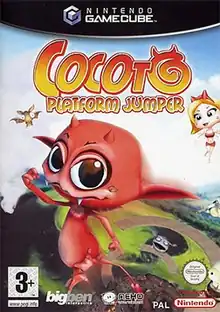Cocoto Platform Jumper
Cocoto Platform Jumper is a platform game developed by Neko Entertainment and published in 2004 in PAL regions by BigBen Interactive for PlayStation 2 and GameCube. Versions were later released for Microsoft Windows (2006) and Game Boy Advance (2007), then for Wii in North America and PAL in 2009.[1]
| Cocoto Platform Jumper | |
|---|---|
 | |
| Developer(s) | Neko Entertainment |
| Publisher(s) | BigBen Interactive Neko Entertainment |
| Composer(s) | Raphaël Gesqua |
| Platform(s) | GameCube, PlayStation 2, Game Boy Advance, Windows, Wii |
| Release | PlayStation 2
|
| Genre(s) | Platform |
| Mode(s) | Single-player |
Gameplay
The game sees players controlling Cocoto, a little red imp, across a number of spiraling levels. The gameplay is very similar to that of Taito's Rainbow Islands: The Story of Bubble Bobble 2, with the player using magma arches the same way as the rainbows in said game, collecting items and power-up, defeating enemies, and reaching the top of the level before time runs out. Cocoto can use his pitchfork as a projectile to defeat enemies, or use the arches. Fairy will appear as a checkpoint. The game features 40 levels spanning across 5 different worlds. There are 30 enemies that vary depending on the level, and the end of each world features a boss fight. There is a two player battle mode where both players defeat each other's imps, and a four player race, where the first imp that reaches the top is the winner.
The Game Boy Advance version has the game play in 2D due to technical limitations.
Development
Cocoto Platform Jumper was created with the intent for the game to be "simple and easy" for everyone, and was inspired by the video game Nebulis. They spent weeks fine-tuning the levels in order to make them appropriately balanced for difficulty.[2]
The game was re-released on the Wii's WiiWare service. Initially, they considered adding new modes and refining old ones, but opted to simply add Wii Remote motion controls.[2]
Reception
| Aggregator | Score | |||
|---|---|---|---|---|
| GBA | GC | PS2 | Wii | |
| Metacritic | N/A | N/A | N/A | 59/100[3] |
| Publication | Score | |||
|---|---|---|---|---|
| GBA | GC | PS2 | Wii | |
| GamePro | N/A | N/A | N/A | |
| GameSpot | N/A | N/A | N/A | 4/10[5] |
| IGN | N/A | N/A | N/A | 6/10[6] |
| Jeuxvideo.com | 11/20[7] | 12/20[8] | 12/20[9] | N/A |
| Nintendo Life | N/A | N/A | N/A | 7/10[10] |
| Official Nintendo Magazine | N/A | N/A | N/A | 60%[11] |
The Wii version received "mixed" reviews according to the review aggregation website Metacritic.[3]
References
- Calvert, Darren (December 14, 2008). "Neko Porting Two More Playstation 2 Titles to WiiWare". Nintendo Life. Gamer Network. Archived from the original on October 30, 2019. Retrieved October 30, 2019.
- Olimar, Brody (April 27, 2009). "Interviews: Cocoto Platform Jumper - Neko Entertainment". Nintendo Life. Archived from the original on July 1, 2022. Retrieved May 14, 2023.
- "Cocoto Platform Jumper for Wii Reviews". Metacritic. CBS Interactive. Archived from the original on 2023-02-12. Retrieved 2023-05-14.
- Ramsey, Andrew (May 1, 2009). "WiiWare: Cocoto Platform Jumper". GamePro Arcade. IDG Entertainment. Archived from the original on May 2, 2009. Retrieved October 30, 2019.
- Watters, Chris (April 28, 2009). "Cocoto Platform Jumper Review (Wii)". GameSpot. CBS Interactive. Archived from the original on October 30, 2019. Retrieved October 30, 2019.
- Thomas, Lucas M. (April 27, 2009). "Cocoto Platform Jumper Review (Wii)". IGN. Ziff Davis. Archived from the original on October 30, 2019. Retrieved October 30, 2019.
- hiro (January 23, 2007). "Test: Cocoto Platform Jumper (GBA)". Jeuxvideo.com (in French). Webedia. Archived from the original on October 30, 2019. Retrieved October 30, 2019.
- Jihem (December 16, 2004). "Test: Cocoto Platform Jumper (NGC)". Jeuxvideo.com (in French). Webedia. Archived from the original on October 30, 2019. Retrieved October 30, 2019.
- Jihem (July 9, 2004). "Test: Cocoto Platform Jumper (PS2)". Jeuxvideo.com (in French). Webedia. Archived from the original on October 30, 2019. Retrieved October 30, 2019.
- Schreiner, Paul (April 29, 2009). "Cocoto Platform Jumper Review (WiiWare)". Nintendo Life. Gamer Network. Archived from the original on October 30, 2019. Retrieved October 30, 2019.
- "Cocoto Platform Jumper Review (Wii)". Official Nintendo Magazine. Future plc. August 2009. p. 103.